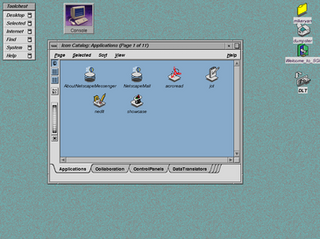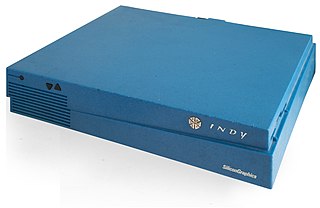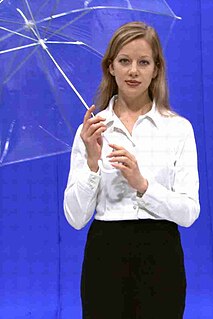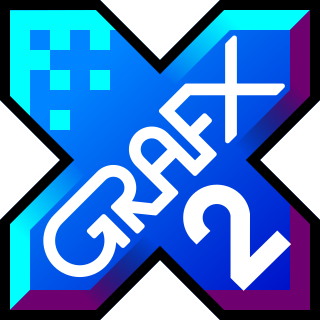
IRIX is a discontinued operating system developed by Silicon Graphics (SGI) to run on the company's proprietary MIPS workstations and servers. It is based on UNIX System V with BSD extensions. In IRIX, SGI originated the XFS file system and the industry-standard OpenGL graphics system.

Silicon Graphics, Inc. was an American high-performance computing manufacturer, producing computer hardware and software. Founded in Mountain View, California in November 1981 by Jim Clark, its initial market was 3D graphics computer workstations, but its products, strategies and market positions developed significantly over time.

Video editing software, or a video editor is software used performing the post-production video editing of digital video sequences on a non-linear editing system (NLE). It has replaced traditional flatbed celluloid film editing tools and analog video tape-to-tape online editing machines.

A workstation is a special computer designed for technical or scientific applications. Intended primarily to be used by a single user, they are commonly connected to a local area network and run multi-user operating systems. The term workstation has also been used loosely to refer to everything from a mainframe computer terminal to a PC connected to a network, but the most common form refers to the class of hardware offered by several current and defunct companies such as Sun Microsystems, Silicon Graphics, Apollo Computer, DEC, HP, NeXT and IBM which opened the door for the 3D graphics animation revolution of the late 1990s.

Color grading is a post-production process common to filmmaking and video editing of improving the appearance of an image for presentation in different environments on different devices. Various attributes of an image such as contrast, color, saturation, detail, black level, and white point may be enhanced whether for motion pictures, videos, or still images. Color grading and color correction are often used synonymously as terms for this process and can include the generation of artistic color effects through creative blending and compositing of different images. Color grading is generally now performed in a digital process either in a controlled environment such as a color suite, or in any location where a computer can be used in dim lighting.

The Indy, code-named "Guinness", is a low-end multimedia workstation introduced on July 12, 1993. Silicon Graphics Incorporated (SGI) developed, manufactured, and marketed Indy as the lowest end of its product line, for computer-aided design (CAD), desktop publishing, and multimedia markets. It competed with Intel x86 computers, and with Windows and Macintosh, including using their files and running their applications via software emulation. It is the first computer to come standard with a video camera, called IndyCam. Indy was repackaged as a server model called Challenge S. Indy was discontinued on June 30, 1997 and support ended on December 31, 2011.
Autodesk Media and Entertainment is a division of Autodesk which offers animation and visual effects products, and was formed by the combination of multiple acquisitions. In 2018, the company began operating as a single operating segment and reporting unit.
Elan Graphics is a computer graphics architecture for Silicon Graphics computer workstations. Elan Graphics was developed in 1991 and was available as a high-end graphics option on workstations released during the mid-1990s as part of the Express Graphics architectures family. Elan Graphics gives the workstation real-time 2D and 3D graphics rendering capability similar to that of even high-end PCs made over ten years after Elan's introduction, with the exception of texture mapping, which had to be performed in software.
The Advanced Visualizer (TAV), a 3D graphics software package, was the flagship product of Wavefront Technologies from the 1980s until the 1990s.
QFX is an image editing computer program developed by Ron Scott, a Texan photographer and software engineer. The first version was released in 1990. At the time of its release, QFX was one of the most feature-rich image editing applications available on the PC platform. It was the software of choice for digital artists and image postproduction studios in the times when 1024x768 truecolor graphics were a luxury, far before Photoshop could have been considered a serious professional tool. Its clean interface and clever workflow helped build a devoted user base, some of whom continue using it, despite QFXs being long ago eclipsed in features and users by Photoshop.
Wavefront Technologies was a computer graphics company that developed and sold animation software used in Hollywood motion pictures and other industries. It was founded in 1984, in Santa Barbara, California, by Bill Kovacs, Larry Barels, Mark Sylvester. They started the company to produce computer graphics for movies and television commercials, and to market their own software, as there were no off-the-shelf computer animation tools available at the time. In 1995, Wavefront Technologies was acquired by Silicon Graphics, and merged with Alias Research to form Alias|Wavefront.

Barco Creator was an image manipulation program targeted at the repro and print shop markets. It was developed by Barco Creative Systems a division of the Barco Group and first shown as a prototype at Parigraph in April 1988, then later at Ipex 88). Barco Creative Systems together with D.I.S.C. and Aesthedes merged into Barco Graphics. It ran on several generations of Silicon Graphics computers till the late 1990s. Barco Graphics ColorTone for Windows NT is considered its successor.
Avid Media Illusion was a digital nonlinear compositing software by Avid Technology targeted at the film and television markets. It ran on Silicon Graphics workstations. The main features were paint, compositing, image manipulation and special effects.

Elastic Reality was a warping and morphing software application available on Windows, Macintosh, Silicon Graphics workstations and was discontinued in 1999.

Primatte is a brand of chroma key software used in motion picture, television and photographic host applications to remove solid colored backgrounds and replace them with transparency to facilitate ‘background replacement’. It uses a unique algorithm based on three multi-faceted polyhedrons floating in RGB colorspace that are used to isolate color regions in the foreground image. Primatte is often referred to as a compositing technology and is usually used as a plug-in for host products such as Adobe After Effects, Adobe Photoshop, Autodesk Media and Entertainment Inferno or Flame, Eyeon Fusion and several other compositing and editing software packages.
Xsgi is the X Window System (X11) server for the IRIX-based graphical workstations and servers from Silicon Graphics (SGI). Xsgi was released in 1991 with IRIX 4.0 on the SGI Indigo workstation.
IrisVision is an expansion card developed by Silicon Graphics for IBM compatible PCs in 1991 and is one of the first 3D accelerator cards available for the high end PC market. IrisVision is an adaptation of the graphics pipeline from the Personal IRIS workstation to the Micro Channel architecture and consumer ISA buses of most modern PCs of the day. It has the first variant of IRIS GL ported to the PC, predating OpenGL.

GrafX2 is a bitmap graphics editor inspired by the Amiga programs Deluxe Paint and Brilliance. It is free software and distributed under the GPL-2.0-or-later license.

Image editing encompasses the processes of altering images, whether they are digital photographs, traditional photo-chemical photographs, or illustrations. Traditional analog image editing is known as photo retouching, using tools such as an airbrush to modify photographs or editing illustrations with any traditional art medium. Graphic software programs, which can be broadly grouped into vector graphics editors, raster graphics editors, and 3D modelers, are the primary tools with which a user may manipulate, enhance, and transform images. Many image editing programs are also used to render or create computer art from scratch.









